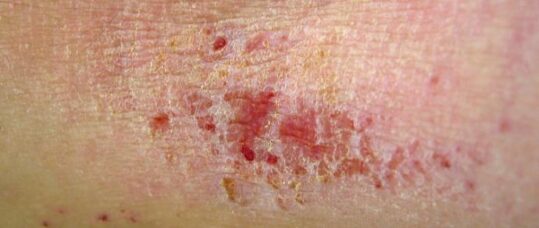‘I don’t want to use topical steroids – they’ll damage my skin’


Debunking common patient myths and misconceptions
The myth
Related Article: Diagnosis Connect service will link people to advice from charities
Topical steroids are dangerous to use.
The reality
Topical steroids are the most frequency prescribed dermatology drugs and have been used to treat inflammatory skin conditions for 60 years. Yet many patients, parents, carers, and even some healthcare professionals express serious concern when topical steroids are advised. This has been termed in dermatology as ‘steroid phobia’ because the anxieties are out of proportion to the potential side effects of topical steroids.1 In day-to-day practice it is commonplace to hear people say: ‘Topical steroids are dangerous,’ ‘Topical steroids thin and damage skin,’ or ‘I’m not going down the steroid road’.
Topical steroids are a medicine and all medicines have potential side effects and the potential to be dangerous if used incorrectly. However, this myth generalises a false belief about a large number of topical medications, all of which have different potencies and formulations. This myth has come from the 1960s, when topical steroids were introduced as a breakthrough treatment for inflammatory skin diseases, particularly eczema. Topical steroids were prescribed in vast quantities and used long-term, often for months with no break. Infants and small children were prescribed the same potent topical steroids as adults, usually mixed in with emollients, which were applied in large quantities with the skin wrapped in cling film to increase steroid absorption. By the 1970s the legacy of this practice was seen with these patients developing permanent skin damage from skin atrophy and striae, and some patients suffering systemic effects.
By the 1980s, there was a range of topical steroids, ranging from mild (1% Hydrocortisone), moderate (clobetasone butyrate), potent (betamethasone) and very potent (clobetasol propionate). The use of topical steroids became much more judicious and the public became aware of the potential side effects, especially skin thinning by previous misuse in the last decades.
In the 1990s, topical steroids were used in different potencies depending on the age of the patient, severity of eczema, and area of the body. The fingertip unit measurement (FTU) was introduced to give an appropriate dosing for topical steroids;2 topical steroids and emollients were prescribed separately, with topical steroids advised for short-term treatment cycles.
Related Article: CVD prevention must be national health priority, says report
The NICE guidelines for children under 12 years with atopic eczema was published in 2007 and the stepped treatment approach is still the gold standard.3 This means tailoring the treatment for the severity of atopic eczema, with emollients always forming the basis and topical steroids stepped up and down. NICE also states that potent steroids should not be used in children under 12 months and topical steroids should only be used under wraps or bandages on dermatological supervision and for no longer than 14 days.3
Exploring the history of topical steroid use explains shortfalls in past practice. Now clinical decision making in prescribing and recommending topical steroid treatment is evidence-based, ensuring efficacy of treatment and minimising side effects. However the topical steroids myths still prevail and form a major contribution to treatment failure in atopic eczema. In this era, information comes from many sources, patients and carers often do not find evidence-based sources and healthcare professionals can also be uncertain in correct topical steroid use and what to advise patients.
Topical steroids are a first-line therapy for many inflammatory skin conditions, including infants and children with atopic eczema, so ‘the steroid road should be well travelled’. In order to reassure patients and carers on using topical steroids safety and avoiding side effects, the following principle should be adhered to:
- Use the least potent topical steroid to control inflammation – matching potency of topical steroid to the severity of the disease.
- Use different potencies for certain body areas (i.e. mild and moderate potencies only for the face and flexures).
- Use a stepped approach to treatment applying topical steroids for short bursts of treatment, start when a flare is evident and step-down when the flare subsides – usually seven days, reduce to every other day for a week, then return to emollients only.
- Use once or twice a day, as indicated and no more frequently. Once-daily has been proved to be as effective as twice- daily.4
- Use the correct amount and application technique – one FTU is equivalent to two measured areas of eczema, by an adult flat palm.
- Apply thinly, not sparingly.
- Use mild to moderate topical steroids under occlusion, with health care professional supervision.
- Use plenty of emollients continual basis to treat dry skin in the chronic phase – which can help prevent inflammation and flare-ups.
Julie Van Onselen is an independent dermatology nurse and director of Dermatology Education Partnership Ltd
References
Related Article: Postnatal contraception advice reduces the risk of back-to-back pregnancies
- Li Aw, Yin ES, Antaya RJ. Topical corticosteroid phoebia in atopic dermatitis: A systemic review. JAMA Dermatol 2017;53:1036-42
- Long CC, Finlay AY. The finger-tip unit – a new practical measure. Clin Exp Dermatol 1991;16:444-7
- NICE. CG57: Atopic Eczema in Children – management of atopic eczema in children from birth up to the age of 12 years. London;NICE:2007
- Williams HC. Established corticosteroid creams should be applied only once daily in patients with atopic eczema. BMJ 2007;334:1272
Resources
- National Eczema Society. Factsheet: Topical Steroids. London;National Eczema Society:2016
Nursing in Practice Events visit 12 locations across the UK and cover topics such as dermatology. If you would like to learn more please visit nursinginpractice-events.co.uk

See how our symptom tool can help you make better sense of patient presentations
Click here to search a symptom


Topical steroids are the most frequency prescribed dermatology drugs and have been used to treat inflammatory skin conditions for 60 years. Yet many patients, parents, carers, and even some healthcare professionals express serious concern when topical steroids are advised.



